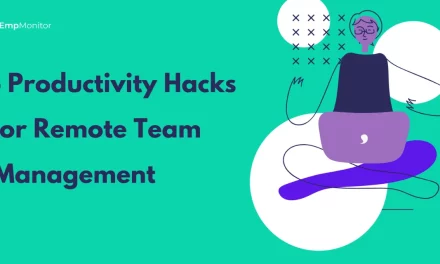Have you ever noticed your hard work going unnoticed at the office? Or maybe your role feels smaller, like you are being left out of important meetings? This could be a sign of quiet firing meaning you are being gradually pushed out without direct notice.
You could be experiencing quiet firing meaning, where you’re gradually pushed out of your role without formal notice.
In 2025, this workplace trend is becoming a big deal, and knowing how to recognize it early could save your career.
But what exactly does quiet firing meaning? And how can you spot the red flags before it derails you or your team?
Let’s break it down.
In a hurry? Listen to the blog instead!
What Quiet Firing Meaning Is & Why It Matters?
Quiet firing meaning refers to a pattern where an employer intentionally sidelines an employee, without initiating a formal termination.
The goal is not always to fire directly but to create enough discomfort, frustration, or stagnation that the employee eventually leaves on their own.
This is not about poor performance reviews or misconduct.
Quiet firing meaning, typically happens without documentation, feedback, or official warnings.
It’s the slow withdrawal of support, recognition, or opportunities that gradually makes an employee feel unwanted or undervalued.
Unlike traditional layoffs or even performance-based exits, quiet firing meaning is far more ambiguous, and that’s what makes it problematic. Employees often don’t realize it’s happening until the damage is done.
Silent firing meaning going above office politics. It’s a product of weak communication, untrained leadership, and often, poor visibility into how employees are doing, especially in remote or hybrid environments.
Some subtle yet common tactics include:
- Removing key responsibilities without explanation
- Skipping one-on-ones or development reviews
- Delaying or denying promotions without clarity
- Offering minimal feedback or none at all
And while this might save management from having difficult conversations, the long-term cost is significant: low morale, higher attrition, and a toxic perception of the organization.
Quiet Firing Vs Soft Quitting: Key Differences
Why Understanding the Difference Matters?
It’s easy to confuse quiet firing meaning with soft quitting—after all, both involve silence, disengagement, and someone gradually stepping away from their role.
But here’s the key distinction: Quiet firing meaning is driven by the employer, while soft quitting comes from the employee.
Let’s break it down.
What Is Soft Quitting?
Soft quitting refers to passive employee disengagement, where someone does just enough to get by but has mentally checked out. There’s no ambition, no collaboration, and no extra effort. It’s quiet, but it’s still a decision made by the employee.
This can happen when employees feel undervalued, overworked, or disconnected from the company’s mission. But not always. Sometimes, it’s a response to wait for it to quiet firing.
What Drives Quiet Firing?
Quiet firing meaning is often intentional. It’s a strategy (or an avoidance tactic) used by some managers to sidestep tough conversations, formal HR processes, or legal risks. They don’t fire the employee directly—they just push them to the margins.
Here are a few scenarios where quiet firing tends to show up:
- A manager lacks the emotional intelligence to address underperformance directly
- Leadership wants to avoid paying severance or facing legal liability
- The organization doesn’t have a strong performance management structure in place
- Bias—conscious or unconscious—leads to selective disengagement
In 2025’s work-from-anywhere model, these patterns are easier to hide but harder to fix without visibility.
When employees feel quiet fired, it’s often because they are. And if no one’s tracking behavior, communication, or workload trends, these patterns go unnoticed until it’s too late.
That’s why HR and managers need to distinguish between genuine disengagement from the employee and passive neglect from leadership.
It’s also why having an employee monitoring software like EmpMonitor isn’t about micromanaging; it’s about noticing early signs you’re being watched at work, detecting signs of imbalance, and stepping in with fairness.
What Are The 10 Signs Of Quiet Firing?
Recognize the Red Flags Before It’s Too Late
Quiet firing meaning does not come with an official memo or an HR meeting. It creeps in through subtle shifts in treatment, communication, and expectations—often justified under the radar of performance management.
For employers, recognizing these patterns is a first step toward prevention. For employees, awareness is crucial to protect career momentum and psychological safety.
Here are ten recurring signs that may indicate someone is being quietly fired in 2025:
Stalled Promotions & Career Development
When an employee’s growth suddenly pauses, with no clear goals, no leadership opportunities, and no feedback, it’s not always accidental. Lack of direction often signals that the organization doesn’t see them in its long-term plans. If high-performers are passed over with no explanation, that’s not mismanagement, it could be quiet firing meaning at play.
Financial Recognition Suddenly Disappears
If an employee is consistently denied financial growth, even when results are solid, it might be a soft push to exit. This quiet erosion of benefits sends a message: you’re not worth the investment.
Reassigned or Reduced Responsibilities
When responsibilities are taken away with no explanation, or reassigned to others—employees are left questioning their relevance. Especially when projects they enjoyed or excelled at are suddenly removed, it reflects a deeper disengagement. This tactic can drain motivation without ever needing to say, “You’re no longer a fit.”
Given Only Mundane or Administrative Tasks
Another hallmark of quiet firing meaning is job stagnation. Once-challenging assignments are replaced with repetitive, low-impact tasks that don’t stretch skills or drive outcomes. Over time, this wears down engagement and signals a subtle detour away from core contributions.
Isolation from Core Communication Channels
Being excluded from meetings, team messages, or strategy conversations is more than a scheduling oversight—it’s a form of silent disengagement. If someone was once part of the loop and is now sidelined, they’re not being consulted for a reason. In hybrid teams, this exclusion often flies under the radar.
Absence of Constructive Feedback or Recognition
When employees no longer receive feedback—good or bad—it erodes clarity and connection. Worse, some may experience hyper-critical reviews that feel personal, not professional. This shift in tone or silence often signals that managers have mentally checked out.
No Support During Roadblocks or Pushback
Support from management isn’t just about resources—it’s about advocacy. If a team member faces internal conflict, technical challenges, or client issues, and leadership remains silent, it sends a message: you’re on your own. This abandonment is a core tactic in soft firing.
Assigned to Solo Work, Irregular Hours, or Separate Locations
When someone’s schedule or work pattern becomes disjointed from the team—assigned late shifts, isolated desk space, or solo assignments—they’re likely being distanced. This is especially common in service or field-based roles, where logistics can mask exclusion.
Unrealistic Workloads With Unpredictable Deadlines
Another sign of being quietly fired? Being overwhelmed—strategically. Some managers assign impossible deadlines or backload work near closing hours. Inconsistent workloads and shifting expectations are used to paint the employee as unreliable or underperforming, even when that’s not the case—often leading to a disengaged employee who feels set up to fail.
Documentation Demands Without Dialogue
Being told to “document everything” while getting zero guidance or collaboration from leadership is a pattern worth noting. This demand for detail, when not balanced with active communication, often sets the stage for future accountability claims, without ever offering support.
Related Article
How To Motivate A Disengaged Employee In 2025?
How To Recognize The Signs You’re Being Watched At Work In 2025?
Why Quiet Firing Impacts Team Culture?
Quiet firing meaning is not just a concern for the employee involved, it affects the entire team and, ultimately, the organization as a whole. What starts as a subtle withdrawal of support or opportunities can slowly erode trust, morale, and productivity across the board.
Here’s how it happens:
1. It Undermines Trust Between Employees and Leadership
When one person is quietly moved, other team members notice, even if it’s not talked about openly. It creates an undercurrent of suspicion. Employees may start wondering: “If it can happen to them, could it happen to me?” This kind of doubt harms the relationship between managers and staff, making open communication feel risky and unsafe.
2. Fosters a Culture of Fear and Uncertainty
Quiet firing meaning does not just affect one person—it sends a signal to everyone else. If employees start to feel like their career path is unclear or their hard work goes unnoticed, they begin to wonder where they stand. Are they being set up for the same treatment? This uncertainty can create an atmosphere of fear, where people stop taking initiative or voicing their opinions, just to avoid rocking the boat.
3. Leads to Lower Engagement and Performance
When people feel like they are not valued, their work suffers. Employees who experience or witness quiet firing meaning, tend to disengage, they stop going the extra mile because they don’t see the benefit. They’re not going to push themselves to contribute more if they feel like their efforts won’t be recognized or rewarded.
4. Increases Employee Turnover
Talent does not stick around in an environment where they feel disposable. If employees feel they are being sidelined, whether through reduced responsibilities, denied promotions, or lack of feedback, they start looking for opportunities elsewhere. Quiet firing, in this case, can create a domino effect: one departure leads to more departures, as people seek more supportive, fair work environments.
5. Damages the Company’s Reputation
Word gets out, especially now. Whether it’s through a candid conversation with a colleague, a review on Glassdoor, or even a quick LinkedIn post, employees and former employees talk.
If your company has a reputation for quietly firing people without warning or communication, it’ll affect not just your retention but your hiring efforts too.
That’s why EmpMonitor comes in; it can help you monitor employee engagement, giving you the tools to handle issues like quiet firing meaning before they escalate.
How EmpMonitor Can Help Prevent This?
EmpMonitor is an employee monitoring software that is built to help businesses keep an eye on the performance, productivity, and security of their employees.
EmpMonitor isn’t just about tracking performance; it’s about understanding your team. Monitoring communication patterns, task assignments, and feedback gives you clear insights into how employees are doing before things like quiet firing become an issue.
Here’s a quick look at some of the key features that make EmpMonitor stand out.
Workforce Productivity & Engagement: EmpMonitor’s suite of tools empowers your team to be more productive and engaged. By analyzing work patterns, the software helps you foster a more engaged workforce while maximizing efficiency.
Time-Tracking for Accountability: EmpMonitor’s time-tracking feature helps you understand how your employees are using their time throughout the day. Automated reports show productive hours versus idle time, so you can assess performance and ensure everyone is staying on track.
User Activity Monitoring: EmpMonitor takes user activity monitoring to the next level with context-rich reports that analyze your team’s actions on a daily or hourly basis. This helps you spot potential issues and keep your team focused on their tasks.
Insider Threat Prevention: Security is always a priority, and EmpMonitor helps protect your company from internal threats. The software tracks employee use of company resources, alerting you to suspicious behavior before it becomes a problem, whether it’s negligence or malicious intent.
Attendance Monitoring: Forget the hassle of paper attendance sheets. EmpMonitor’s attendance monitoring software streamlines the process by tracking leave, attendance, and HR management tasks all from one easy-to-use dashboard.
Project Management
Streamline your project management with EmpMonitor. From planning to execution, this feature helps you allocate resources efficiently, track progress, and keep your team collaborating in real-time to meet deadlines.
With these powerful features, EmpMonitor offers a comprehensive solution to help you manage, monitor, and optimize your team’s performance. It’s the all-in-one tool every modern business needs to succeed.
How To Solve Quiet Firing Once It’s Identified?
Recognizing the signs of quiet firing meaning is only the first step. Solving it means reestablishing trust, clarifying expectations, and creating a path forward where employees feel valued and heard.
Here’s how to address quiet firing meaning constructively, without further damaging morale or team cohesion.
Start With a Transparent Conversation
Before making assumptions, start by having a direct and respectful conversation with the employee in question. The goal isn’t to justify past behavior but to create space for honest dialogue. Ask open-ended questions like:
- “How are you feeling about your role lately?”
- “Are there areas where you feel unsupported or overlooked?”
Approaching the situation without defensiveness shows maturity and respect. You may find that the employee has been waiting for this conversation, and that acknowledgment alone can begin to repair the relationship.
Rebuild Role Clarity and Feedback Loops
If roles and responsibilities have blurred or feedback has been inconsistent, now’s the time to correct that. Outline performance expectations clearly and revisit what success in the role looks like. Let employees know how and when feedback will be given—monthly check-ins, weekly one-on-ones, or project-based reviews.
This clarity reduces anxiety and repositions the employee as an active contributor, not a passive observer waiting for a silent push out the door.
Track & Re-engage
After re-establishing expectations, don’t leave follow-through to chance. Use employee management software like EmpMonitor to track performance and engagement metrics objectively. This helps managers:
- Identify if the employee is becoming more active and involved
- Catch any signs of renewed disengagement early
- Make data-informed decisions instead of relying on gut feeling
By using EmpMonitor’s employee monitoring software, you can ensure that interventions lead to progress, and if they don’t, you’ll have clear insights to guide your next move.
Final Thoughts
Quiet firing meaning might be subtle, but its impact is far from silent. From strained communication and inconsistent feedback to reduced responsibilities and isolation, the signs are real—and they’re costing businesses their best talent.
The good news? It doesn’t have to be this way.
By learning how to identify the quiet fired meaning, and understanding the difference between quiet firing vs soft quitting, organizations can address the root cause instead of reacting to the fallout. And with tools like EmpMonitor, solving the issue becomes a system, not just a sentiment.
The real takeaway here? Employees don’t leave bad companies. They leave companies that quietly let them go first.
FAQ
Q1. Is quiet firing illegal in the workplace?
Quiet firing meaning, in itself, isn’t usually illegal, but the methods used (like discrimination or retaliation) can cross legal boundaries. If quiet firing leads to a hostile work environment, it could open the door to legal challenges under employment law.
Q2. Can employee monitoring software detect quiet firing patterns?
Not directly, but it helps uncover behavioral shifts that may be symptoms. For example, consistent isolation, unbalanced workload trends, or sudden drops in engagement can all surface through data logged by employee monitoring software.
Q3. How can HR differentiate between underperformance and being quietly fired?
It comes down to context. If an employee shows effort and consistency but keeps getting sidelined without a clear cause, it’s worth evaluating the manager’s behavior. Documented performance trends, task history, and feedback frequency—all tracked by employee management software—can bring much-needed clarity.
Q4. What’s the difference between being fired and quiet quitting?
Quiet quitting is when employees disengage by doing only the bare minimum. Quiet firing meaning, is when employers disengage, creating conditions that push employees out. One is a passive employee response; the other is a passive employer action.
















